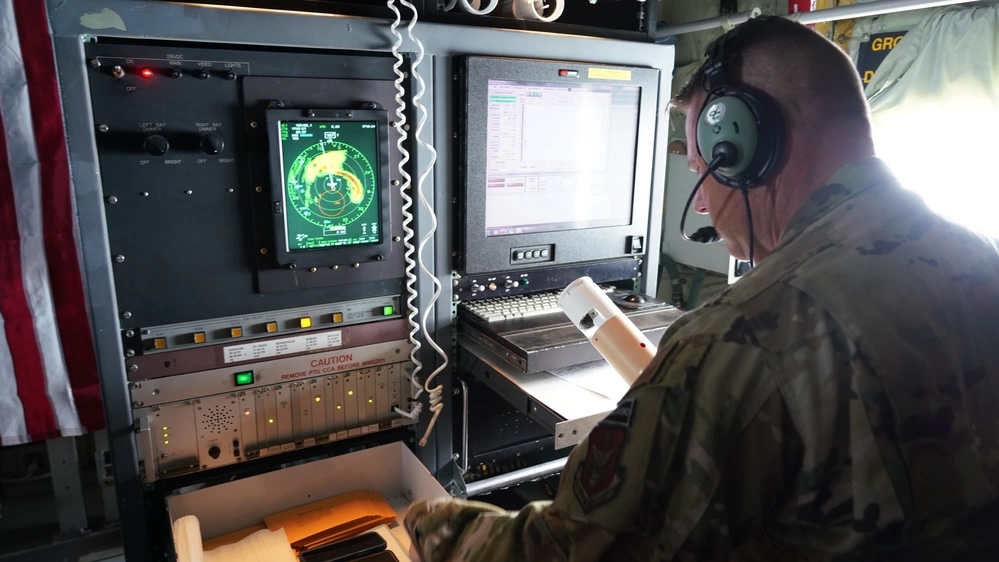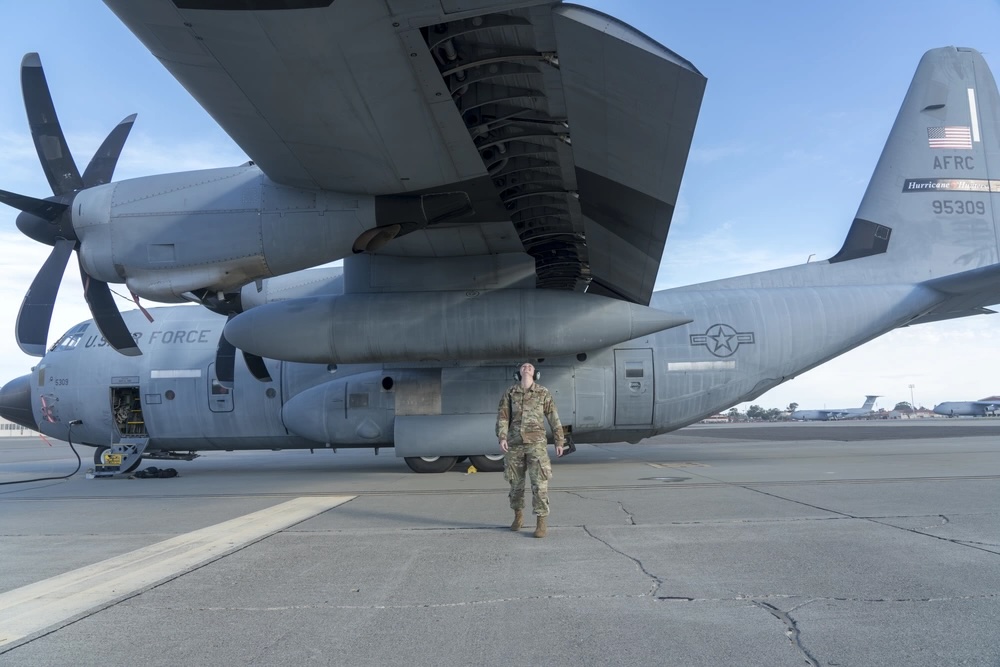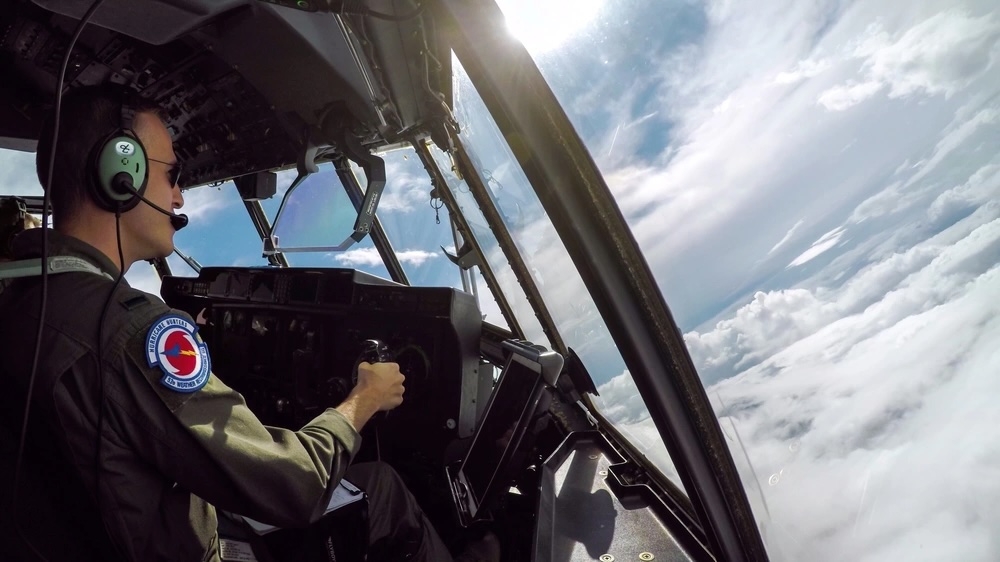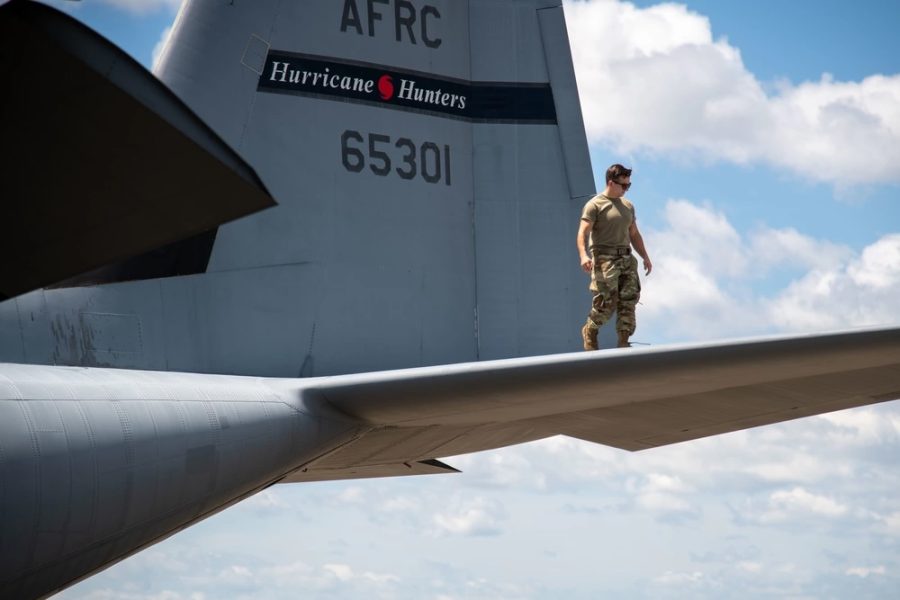While threats like China and Russia dominate the headlines, one Air Force Reserve squadron is focused on another important peril: extreme weather that can devastate both civilian communities and military bases.
“If you ask the wing commander at Homestead [Air Reserve Base], at Tyndall [Air Force Base], at [Joint Base] Charleston, any coastal installation, they’ll tell you the same thing: they rely on that hurricane center forecast that tells them what’s going to happen,” said Maj. Chris Dyke, an aerial reconnaissance weather officer with the 53rd Weather Reconnaissance Squadron, better known as the Hurricane Hunters.
As hurricane season gets longer and storms roam farther north, the Airmen of the 53rd find themselves flying more storms farther from their home station with the 403rd Wing at Keesler Air Force Base, Miss. There is no rest in the winter, when the squadron travels to the Pacific to gather data on atmospheric rivers: massive bodies of vapor that dump snow and rain on the west coast. With just 10 aging WC-130J aircraft and 20 crews, the Airmen and their equipment are feeling the pinch.
“The resources we’re working with today were established and set in 1996 and no significant changes have happened since then,” Dyke said. “At that point it was resourced for a six-month hurricane mission. We are now a 10-month operational mission and a two-month road show. … To be honest, it’s not enough time for the aircraft.”
Hurricanes
Every summer, the 53rd flies WC-130Js into storms over the Atlantic and Caribbean. The data they gather via the aircraft and dropsondes—small cylinders that drop out of the aircraft and parachute to the sea—help scientists at the National Hurricane Center predict the size of the storms and where they will make landfall, which in turn helps decision-makers make calls such as evacuation orders.

Better information also saves money; it costs at least $1 million to evacuate a mile of coastline, and it costs Air Force base commanders money to evacuate aircraft in advance of a storm. The data gathered by the 53rd helps narrow the track of a hurricane and reduce the number of evacuations. But as science improves, the Hurricane Hunters are being asked to fly more sorties.
“The hurricane center moving from a three-day to a five-day to a seven-day forecast is great, especially for me as a coastal resident,” Dyke said. “But with that comes added work, because now we’re going to be flying the storm earlier in its development.”
The 53rd saw an 18 percent increase in demand flying hurricanes since 2018, the major said. They are also flying into potential tropical cyclones to gather early data, and the last few seasons they have flown up to Canada as storms travel farther north. The National Oceanic and Atmospheric Administration (NOAA) also has Hurricane Hunters who fly into storms, but they gather different sets of data.
“The research that comes from NOAA’s data helps change the equations in the model, while we collect data that goes into the model that is actively running,” Dyke said.
The demand is increasing so much that the 53rd WRS can’t fly them all, which leaves gaps in storm data. Just last year, the squadron had to pull aircraft out of the Caribbean island of St. Croix and send them back to Keesler in order to track Hurricane Idalia, which was deemed the more important storm.
“That was an example where we’re asking the hurricane center, ‘OK, pick and choose, what’s your priority?’” Dyke said. “There are impacts from the one we don’t fly. We’re talking about potential impacts to stateside readiness, homeland defense.”
The hurricane season keeps the 53rd busy all summer, and a relatively new mission has them flying through the winter too.

Atmospheric Rivers
Over the Pacific Ocean flow mighty atmospheric rivers: bodies of water vapor that can carry 15 times the water flow equivalent of the mouth of the Mississippi River, according to NOAA. When the rivers make landfall, that vapor can turn into heavy rain, snow, and flooding which can damage infrastructure. The rivers also affect how deep local governments draw water from their reservoirs.
“That has significant impacts on the Central Valley, we’re talking about the national food supply,” said Dyke, referring to California’s role in growing much of the country’s fruits, vegetables, and nuts. “It has effects on those DOD installations in that area, so it has a duplicative effect on wartime readiness as well as national security and homeland defense.”
Since 2016, the 53rd has flown atmospheric river missions as far as Guam to provide better data on when and where the rivers arrive. In 2022, the data they gathered provided another 72 hours of decision time for emergency planners, which allowed them to pre-position search and rescue teams and supplies and help make “over 600 swift water rescues” possible, Dyke said.
The demand for atmospheric river missions has increased 606 percent since 2018. Combined with the hurricane season, fiscal 2023 saw the highest number of operational flying hours in the past nine years for the 53rd WRS, and fiscal 2024 is on pace to meet or exceed that. But the Hurricane Hunters do not have the resources to keep pace.

Weathering the Weather Planes
When it adopted the WC-130J in 1999, the 53rd Weather Reconnaissance Squadron was among the first units in the Air Force to fly the ‘J’ model, the latest version of the venerable C-130 aircraft. But 25 years later, the fleet is feeling the effects of a quarter century of rough skies.
“Because it’s aging, it gets worse each year, and so the vast majority of your non-mission capable time is scheduled maintenance, and that increases each year,” said Col. William Magee, commander of the 403rd Maintenance Group.
Hail in particular takes a toll: last year maintainers had to change out an aircraft’s propellers and radome (the nose cone) after flying through Hurricane Ian. The salty sea air also corrodes the aircraft faster. Magee estimated he usually has eight aircraft available for missions at any given time, with the other two down for maintenance.
“I’m not authorized to say when enough is enough, but we are growing our storm missions at a rate where about every two years, we would need another airplane,” he said.
The pace takes a toll on the people too. During hurricane season, the squadron sends a team of 35 maintainers and 35 crew members on the road to work out of airfields closer to the storms. In the winter, teams hit the road again for California and atmospheric rivers.
“We’re happy to do it, we love the mission, but it does take us away from home a lot,” Magee said. “That means some wear and tear on the families.”
Ten of the five-member Hurricane Hunter crews are made up of full-time reservists, while the other 10 are traditional part-time reservists, but all are feeling the strain. The demand “is just continuing to grow, and when you have the same resources that are in place, those are the same full-time crews, occasional part-time crews that are flying those year after year,” said Dyke. “So yeah, it’s definitely taking a toll on the people.”
Tech Refresh
A forecast model is only as good as the data feeding it, Dyke explained. As modeling improves, scientists need different kinds of data to help planners make decisions. The 53rd Weather Reconnaissance Squadron could provide that data with new sensors and technology, but the funding bucket for those upgrades, the National Guard & Reserve Equipment Appropriation (NGREA) usually is not big enough to cover it and all the other national security priorities.
“While weather reconnaissance is number one on my list, there are other competing priorities: great power competition,” said Dyke. “So it’s a rack and stack and the NGREA pot’s only so big.”

One potential modernization is a broadband upgrade that would let the Hurricane Hunters send real-time high-definition video of radar footage back to the National Hurricane Center as they fly through a storm.
“Right now, we’re able to send the radar imagery we compile from flights in a video file after the fact,” Lt. Col. Tobi Baker, an aerial reconnaissance weather officer, said in a 2021 press release. “That’s great for research purposes, but being able to send the video in real time will be beneficial for those people on the ground putting out the watches and warnings as it will give them a better idea of what’s going on in and around the eye or center of a storm.”
Broadband access would “open up our data pipe to push more information at a quicker pace,” Dyke said. Other upgrades include a better Doppler Radar that could capture higher-resolution data and a dynamic sensor pod that would let crews swap out sensors for different missions. But the upgrade pace is glacial, which is frustrating when several already exist on the commercial market.
The 53rd WRS receives some funding from the Navy and other agencies which benefit from the squadron’s work, but overall the funding structure does not keep pace with modern demands, unit members said.
What would a better funding mechanism look like? The 2024 National Defense Authorization Act requires a report on whether the Hurricane Hunters and their counterparts in NOAA need more resources to carry out their mission through 2035. The report was due 90 days after the bill was signed into law on Dec. 22, but Maj. Gen. C. McCauley von Hoffman, the deputy chief of the Air Force Reserve, said it’s still under development.
“I think that there’s recognition, particularly in the coastal state delegations, that this is an important mission that has to be resourced,” Hoffman said. “This request asks ‘are there enough funds to maintain these aircraft, are there enough of them, where does the funding come from, and do we have it right?’”
With so many agencies involved, the current state of funding for the squadron “is kind of a mess,” she added. “So I think part of what they’re asking is ‘what, Air Force, would you say is a better solution?’”


